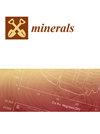Dissolution Mechanisms and Surface Charge of Clay Mineral Nanoparticles: Insights from Kinetic Monte Carlo Simulations
IF 2.2
4区 地球科学
Q2 GEOCHEMISTRY & GEOPHYSICS
引用次数: 0
Abstract
The widespread use of clay minerals and clays in environmental engineering, industry, medicine, and cosmetics largely stems from their adsorption properties and surface charge, as well as their ability to react with water. The dissolution and growth of minerals as a function of pH are closely related to acid–base reactions at their surface sites and their surface charge. The vivid tapestry of different types of surface sites across different types of clay minerals generates difficulties in experimental studies of structure–property relationships. The aim of this paper is to demonstrate how a mesoscale stochastic kinetic Monte Carlo (kMC) approach altogether with atomistic acid-base models and empirical data can be used for understanding the mechanisms of dissolution and surface charge behavior of clay minerals. The surface charge is modeled based on equilibrium equations for de/protonated site populations, which are defined by the pH and site-specific acidity constants (pKas). Lowered activation energy barriers for these sites in de/protonated states introduce pH-dependent effects into the dissolution kinetics. The V-shaped curve observed in laboratory experiments is reproduced with the new kMC model. A generic rate law for clay mineral dissolution as a function of pH is derived from this study. Thus, the kMC approach can be used as a hypothesis-testing tool for the verification of acid–base models for clay and other minerals and their influence on the kinetics of mineral dissolution and growth.粘土矿物纳米颗粒的溶解机制和表面电荷:蒙特卡洛动力学模拟的启示
粘土矿物和粘土在环境工程、工业、医药和化妆品中的广泛应用主要源于它们的吸附特性和表面电荷,以及与水发生反应的能力。矿物的溶解和生长随 pH 值的变化而变化,这与其表面部位的酸碱反应和表面电荷密切相关。不同类型的粘土矿物具有不同类型的表面位点,这给结构-性质关系的实验研究带来了困难。本文旨在展示如何利用中尺度随机动力学蒙特卡洛(kMC)方法,结合原子论酸碱模型和经验数据来理解粘土矿物的溶解机制和表面电荷行为。表面电荷的建模基于去质子化/质子化位点群的平衡方程,这些位点群由 pH 值和特定位点酸度常数(pKas)定义。在脱/质子化状态下,这些位点的活化能垒降低,从而在溶解动力学中引入了与 pH 值相关的效应。新的 kMC 模型再现了实验室实验中观察到的 V 型曲线。这项研究得出了粘土矿物溶解随 pH 值变化的通用速率定律。因此,kMC 方法可作为一种假设检验工具,用于验证粘土和其他矿物的酸碱模型及其对矿物溶解和生长动力学的影响。
本文章由计算机程序翻译,如有差异,请以英文原文为准。
求助全文
约1分钟内获得全文
求助全文
来源期刊

Minerals
MINERALOGY-MINING & MINERAL PROCESSING
CiteScore
4.10
自引率
20.00%
发文量
1351
审稿时长
19.04 days
期刊介绍:
Minerals (ISSN 2075-163X) is an international open access journal that covers the broad field of mineralogy, economic mineral resources, mineral exploration, innovative mining techniques and advances in mineral processing. It publishes reviews, regular research papers and short notes. Our aim is to encourage scientists to publish their experimental and theoretical results in as much detail as possible. There is no restriction on the length of the papers. The full experimental details must be provided so that the results can be reproduced.
 求助内容:
求助内容: 应助结果提醒方式:
应助结果提醒方式:


